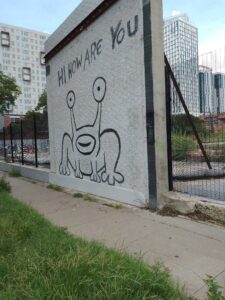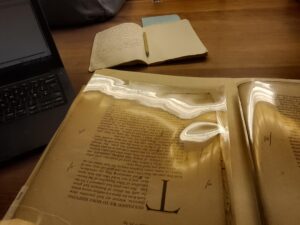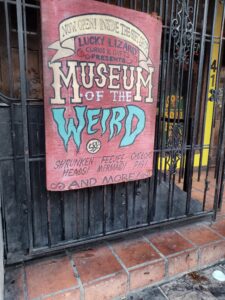
Attention, the sign read: storage of handguns is not allowed in these lockers or areas. Noted, I thought. Another example of the incongruous nature of my visit. This implied that enough handguns had been stored in the lockers that staff at the Harry Ransom Centre needed to put up the sign. It was better than bringing them into the reading room. Once inside, however, I thought no more of firearms in a library. Neither was the Texas heat an issue here. I could move with ease inside the temperature-controlled, air-conditioned space. As a librarian gave me an induction, I noticed R. A. Gilbert’s bibliography of scholar-mystic A. E. Waite on the shelf. Goldstone and Sweetser’s Machen bibliography was not far off. This was familiar ground. Machen’s eye-catching titles prompted the librarian to go back to the desk and look him up on Wikipedia.
The Harry Ransom Centre has links with Joyce (propitious – Machen read an early version of Dubliners for the publisher Grant Richards), and his bust is one of five or six modernists who greet the reader on their way up to the first floor. The original Ransom Centre was founded partly on oil money. Ransom himself, known as the ‘Great Acquisitor’, had to resign in 1971 because he was spending too much. He died five years later. One of his successors was Thomas F. Stanley, a man canny about persuading sellers to part with their sought-after archives. Since the last quarter of the twentieth century it became common for British critics to lament the fact that the papers of British authors were slowly being transferred to Austin. Julian Barnes sold his archive in 2002, Ian McEwan in 2014, Kazao Ishiguro the year after. Some do it for legacy reasons, others for the welcome cash at the end of a difficult career. Penelope Fitzgerald finally released her papers to Texas in 1988, ‘which gives me enough room to put my shoes’ (Letters, p. 316).

There can be no doubt that, had something like the Ransom Centre existed in the 1920s and 30s, Machen would have sold his own papers in a snap. In fact, a wholesale archival purchase may have saved him and his wife from many years of near poverty. Perpetually in need of money just to scrape by and beset by gout and liver failure, Machen appeared more than happy to sell individual items to fans and collectors, particular to Americans. He had even begun to ask for money before he signed anything (as many letters in the HRC attest: by 1927 he was charging autograph hunters £2-0-0 ). The actual Machen collection at the HRC was begun as far back as 1959, when the New York rare book dealer Lew D. Feldman sold a bundle of 575 letters Machen had written to Oliver Stonor. Feldman was instrumental in building up the main collections of HRC and the Berg Collection at the New York Public Library. After the Feldman purchase, regular donations by the bibliographer Adrian Goldstone helped swell the archive and continued until the late 1980s until the collection occupied 8.4 linear feet of shelf space.
So what’s actually in there? Of greatest interest is probably Machen’s notebook dating from the second half of the 1890s, full of jotting for stories and drafts of The Garden of Avallaunius (though this had been usefully transcribed and annotated by Tartarus Press several years ago). More jewels of the collection are the letters Machen composed to a handful of recipients during the last few decades of his life, amounting to over 1,000 items. There are the letters to Stonor, but also to New York bookseller Alfred Goldsmith, Colin Summerford, Harvard academic Robert Hillyer, and superfan John Gawsworth. The Gawsworth material itself is immense, and far too extensive for the short time I had. Reams of bibliographic questions for Machen to answer (On what date was X published? How did you get to know so and so?), on top of drafts of his unpublished biography, Man of Letters, running to many hundreds of pages. Gawsworth was an early Machen obsessive who amassed a strong set of Machenalia over the years. His failure to get the book published must have seemed a bitter reward for a project that had taken him years of research and pestering. Even after Machen’s death in 1947 attempts to secure publishing contracts fell through and Gawsworth was left to reminisce and to manage the estate of his other hero – M. P. Shiel.

And so two days passed quickly: onlookers during the final hours would have seen me flicking desperately through the remaining folders, taking photos with abandon. The evenings were spent trying hard to melt through the tarmac into a nether-Austin, its frozen and less sweaty opposite. This meant I had little time for traditional site seeing. I did, however, get to the Museum of the Weird – south of the capitol building, a block away from Joe Rogan’s comedy club (another incongruity). Three unbeatable floors of an American-style cabinet of curiosities, topped off with a wax museum devoted to the owner’s obsession: Lon Chaney. Then after Jackalopes and wolf boys it was back to the accommodation to prepare for the 5am flight to JFK… The bulk of Machen was already over. But what would be waiting for me in the city of his correspondents?
At least I now had a Big Foot t-shirt.
